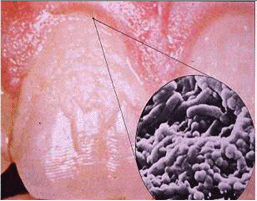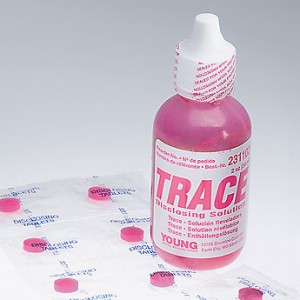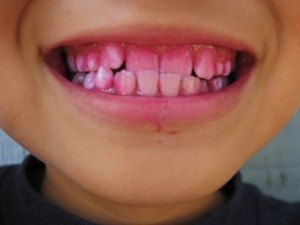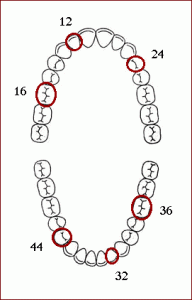
Dental plaque will start forming at the hard to reach places, like at the gum line © smileplus.wordpress,com
In many cases, plaque is difficult for an individual to identify. Plaque can be removed at planned intervals by the dental hygienist or a dentist as part of an oral prophylaxis. However, because daily dental plaque removal is more effective, it is the individual – not the hygienist or the dentist – who is vital for preserving lifelong intact teeth. Therefore it is essential to know the sites in the mouth where tooth plaque tends to accumulate.
How is plaque detected?
Plaque located above the gum margins (supragingival plaque) can be detected with the use of disclosing agents, which are harmless dyes such as the red-staining agent, FD&C Red. You can perform your own self-examination for teeth plaque using over-the-counter plaque disclosing products. Before using a plaque disclosing product, brush and floss your teeth as usual. Then you can choose use any of the following:
- Plaque disclosing solution: Swish the solution around in your mouth for about 30 seconds and spit it out.
- Plaque disclosing tablet: Chew a tablet and let it mix with the saliva in your mouth, then swish the saliva around for about 30 seconds and spit it out.
- Plaque disclosing swab: Use the swabs to wipe the surfaces of your teeth.
- Plaque disclosing floss: Use the floss to show the plaque you’ve removed after you use it as well as to clean through braces or a dental bridge.
Once disclosed, most of the supragingival plaque and food debris can be easily removed by the daily use of a toothbrush, floss and an irrigator.
After using the disclosing agents, your mouth and tongue may be temporarily stained for as long as a day with the harmless dye. Some disclosing tablets make a bright red stain, which can stain clothing whereas some disclosing products have dyes that people may be allergic to therefore be sure to read the package instructions before using.
How is dental plaque measured?
Dental professional can measure plaque on teeth through the following indexes:
O’Leary’s Plaque Record (Index)
The relationship between plaque and gingivitis was first established by Loe et al. in 1965. Seven years later, O’Leary developed one of the first useful and widely used indices to identify the location and extent of plaque. O’Leary’s index is useful for monitoring an individual’s plaque control performance, is easy to accomplish, is economical, and is reproducible. Only a mouth mirror and explorer are necessary. The completed chart indicates the locations where plaque accumulates and where improved brushing and flossing techniques are required.
The total number of scored tooth surfaces is counted; the sum is then divided by the number of available teeth (including pontics and implants), and multiplied by 100 in order to establish the plaque score as a percentage. This baseline plaque score should be compared with future recall scores to objectively monitor an individual’s progress.
The Plaque Index of Silness and Loe
The plaque index of Silness and Loe provides a modification of O’Leary’s index. It too is visual and required only a mouth mirror. A drawback of the O’Leary index is that it requires that the surfaces of every tooth be examined for plaque but that there were no gradations between a great amount of plaque and no plaque.
The index of Silness and Loe also requires that the four surfaces of designated teeth be visually examined and a score recorded from a total of six teeth. For each of the surfaces of these teeth a score of 0 to 3 is given that matches the severity. In this way, the average amount of plaque for each tooth can be determined by dividing by 4; the scores for all six teeth be divided by 6 to get the average for the mouth. The highest scores can be expected to occur on the interproximal surfaces or surfaces in between teeth.
Oral-Hygiene Index and Simplified Oral-Hygiene Index
One of the most popular indicators for determining oral hygiene status in epidemiology studies is the Oral Hygiene Index (OHI). It was developed in 1960 by Greene and Vermillion and modified 4 years later as the OHI-S. The simplified (S) version provides much the same information, as did the earlier version, but can be accomplished much more rapidly. It is very useful for large-scale epidemiology surveys but is not generally believed to be sensitive enough to accurately evaluate the oral hygiene status of an individual.
The OHI has two components: the oral debris score and the calculus score. The term oral debris includes “plaque, materia alba, and food remnants.” With the OHI-S, soft and hard deposits are evaluated only on the facial or lingual surfaces of six selected teeth. The total OHI-S score can be divided by the number of surfaces examined to calculate the average oral hygiene score.


